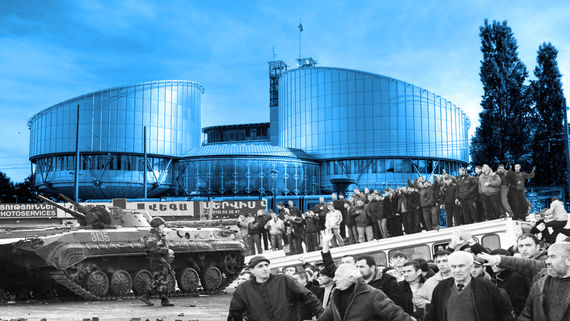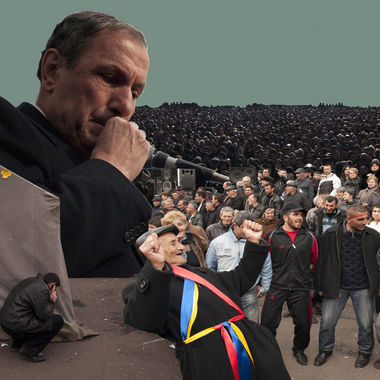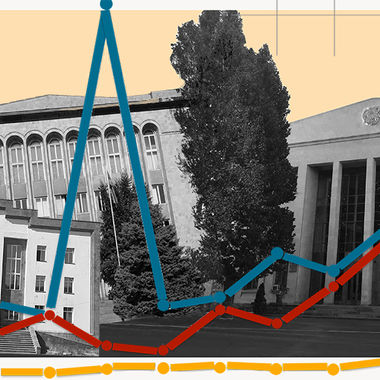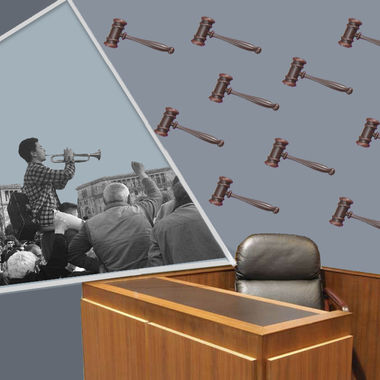Sat Sep 22 2018 · 10 min read
Vahe Grigoryan on the Events of March 1, a Dysfunctional Judiciary and Transitional Justice

By Maria Titizian
The European Court of Human Rights on Thursday, Sept. 20, issued a unanimous judgment in the Saghatelyan vs. Armenia case relating to the tragic events of March 1, 2008, when security forces cracked down on peaceful protesters during post-election demonstrations in Yerevan leaving ten people dead. The protests had begun after a highly contested presidential election that had taken place on February 19. The main candidates were Serzh Sargsyan of the ruling Republican Party and opposition leader Levon Ter-Petrosyan, who had also served as Armenia’s first president between 1991-1998.

The case involved opposition activist Mushegh Saghatelyan, who had camped out with hundreds of other protesters in Yerevan’s Liberty Square in the evening of February 29, morning of March 1. Following the crackdown, Saghatelyan alleged that he had been mistreated by police, that his arrest was unlawful and the criminal case brought against him was fabricated. Saghatelyan was convicted for assaulting two police officers and carrying a knife illegally.
In the judgment it reads that the court unanimously: “Declares admissible the complaints concerning the applicant’s alleged ill-treatment, the failure to carry out an effective investigation, the alleged unlawfulness of his arrest, the failure to inform him promptly of the reasons for his arrest, the lack of a reasonable suspicion and the failure to provide relevant and sufficient reasons for his arrest and detention, the alleged unfairness of his trial, the alleged breach of his right to call witnesses and his right to freedom of expression and freedom of assembly, and the remainder of the application inadmissible.”
The Court held that the Republic of Armenia was to pay Mr. Saghatelyan EUR 15,600 in respect of nonpecuniary damage and EUR 5,000 in respect of costs and expenses.
Vahe Grigoryan, the lawyer representing Saghatelyan at the ECHR said that this was a landmark judgment and the first of its kind relating specifically to the events of the morning of March 1, 2008, when several hundred police officers stormed Liberty Square where protesters had spent the night. The order for the operation was given by then President Robert Kocharyan. Grigoryan noted that the European court found that Saghatelyan’s rights had been violated and rejected the position of the Government of Armenia that the reason for the police operation that morning was due to “information obtained on February 29, 2008 by the Armenian Police and National Security Service, according to which a large number of weapons, including metal rods, wooden clubs, firearms, grenades and explosives, were to be distributed to the protesters to incite provocative actions and mass disorder in Yerevan on March 1, 2008.”
According to Grigoryan, the Court’s findings that the rally in Liberty Square was peaceful and the government’s claim about the existence of weapons was unsubstantiated confirms that the main objective of the authorities in dispersing the gathering in the Square was to discontinue the political protests of the demonstrators. “This means that the use of force commencing from the morning of the first of March had no legal ground, was a politically motivated operation by the authorities and the main aim was to suppress the political protest against electoral fraud during the presidential elections,” he said.
While there are many cases pending at the ECHR relating to events of later that day, Grigoryan has another 10-12 cases similar to Saghatelyan, that are explicitly about the early morning hours of March 1 (he also represents the families of nine of the victims killed following the clashes of that day). “The issue is that the violence commenced early in the morning of March 1 and the Saghatelyan vs. Armenia and Gaspari vs. Armenia are specifically about the events of that morning,” Grigoryan explained. “The violence continuously escalated during the day resulting in ten deaths - two police and eight civilians, not counting the many who were injured, both civilian and security personnel.”
Thereby, the tragic events of later that day were the result of the continuous escalation of violence by police, instigated by the crackdown and the overall logic and purpose of that violence was to suppress and discontinue the political protest against authorities. “This resulted in the use of lethal force by security forces,” Grigoryan said. “Even though police and military personnel used firearms against the protesters, the protests continued near Miasnikyan Square, in the vicinity of the French Embassy. This demonstrated their [the authorities’] willingness to use firearms, the protesters did not stop their demonstration and...the use of lethal force against individual protesters was the last step the authorities applied to disperse the political protest.”
Grigoryan believes that the events of March 1, 2008, ten years on, continues to be an open wound for the country. “All previous commissions and investigations were flawed,” he said. “This has to be resolved.”
The State of Armenia’s Judiciary
The most important outcome of this judgment by the ECHR is the appraisal of the state of Armenia’s judiciary. “The first thing that may flow from this judgment and I’m sure many more judgments will be published about the same context and the various violations of rights of many of the applicants, that is mainly the right to a fair trial and the right to freedom of assembly, is that the Armenian judiciary was unable to resist the political influence of the authorities of the day,” Grigoryan said adding that the judgment proved that the Armenian judiciary was completely dysfunctional those days “if we can even call it a judiciary.”
related
Ten Victims, Ten Years, Zero Culpability
By Hamazasp Danielyan
Ten years after the worst post-election clashes in the history of Armenia’s independent statehood that left ten people dead and hundreds injured, the wounds are still fresh and the pain raw. In this personal essay, Hamazasp Danielyan writes about the events leading up to March 1, 2008 and reflects on his personal transformation.
This indictment of the judiciary is anchored in the fact that during the cases being heard of all those charged with various crimes following the events of March 1, there was not a single dissenting opinion by any Armenian judge in the domestic proceedings. “We are speaking about a situation where all the judges unanimously upheld the charges of the accused,” Grigoryan noted. “The European Court found unanimously that the basic rights of the applicants were violated. This means that they [the judges] were all strongly directed to uphold the political party line of the authorities of that day.” The fact that the judges did not resist and willingly endorsed and promoted the position of those in power highlights the fragility of the judiciary in Armenia, but more importantly, according to Grigoryan, is that while they were pressured to carry out orders from above, they still continued to ‘operate’ as a judiciary of a democratic nation.
The Moment of Truth
Now, more than ever, it is imperative that the reputation of the judiciary be restored and concrete steps are needed to ensure this. “I think that now is the moment of truth,” Grigoryan noted. “The Armenian judiciary should explain what are the ways and methods to improve the situation. The judges involved in these cases should publicly explain the situation in which they acted.”
Grigoryan said that those judges who presided over the cases connected to the events from a decade ago must remember that every party to those proceedings may remind them that they in fact imprisoned people by orders of the political power of the day. “They exchanged their oath of a judge and all the obligations under the oath of a judge for their personal career and prosperity, if they got any,” he said. Many of those judges were promoted after hearing these cases and most of them continue to work in the judicial system of the country. “And I believe it is time now to think about how we should deal with this contingent of lawyers and judges. My understanding is that it is now time for them to go,” Grigoryan added.
The reason the human rights lawyer is focusing his attention on the judges is because in his opinion, investigators and prosecutors may be mistaken, they may be misled by political authorities, and their power misused by the executive power. “It is the judiciary who arbitrates the situation and cases; it is the judiciary which is the last stand for the rule of law, so we should start with the judges,” he says simply. Before dealing with prosecutors or investigators, the process must start with the judges. “These judges should go home, young judges should take their place and their offices and when these young judges come to their offices, they should remember whose office they’re in and why the ones before them left,” he said adding that the time has come for a healthy debate within the judiciary itself to understand what they should do to improve the situation.
The Cost of Justice: ECtHR and Cases Against Armenia
By Lusine Sargsyan
Since joining the Council of Europe and ratifying the European Convention on Human Rights, Armenia’s government has been obligated to pay over 900,000 Euros as compensation to Armenian nationals.
Proportionality of Implementation
If for some reason, the judiciary is unable to heal itself, then the executive and legislative branches can intervene, including also the public. “When we’re speaking about intervention by the other branches of power, or the public, we may forget about the proportionality of intervention,” Grigoryan explained. The judiciary must show resolve and suggest solutions to the public and the other branches of government. “I very much hope that they have the wisdom to do so and not leave it to the legislative or executive power to decide.”
Regarding the details of the ECHR judgment, Grigoryan said he was amazed at how detailed and balanced the language is. He also noted that it is important to remember that this international tribunal is not designed to be a court of first instance or a judiciary of a general jurisdiction to resolve all issues within a country. “We witnessed what happened over the past 15 years. The ECHR was the only hope during this dark period of justice in Armenia and it still confirms and upholds its role,” Grigoryan said. He also noted that the defense team of Armenia’s second President Robert Kocharyan, who was charged with overthrowing constitutional order during the March 1 events also said that they would apply to the ECHR about the alleged violation of Kocharyan’s rights. “We continue to witness that Armenian society does not see the possibility of solutions or remedies within the judiciary of the country, they are still looking to the ECHR.”
The Need for Transitional Justice
Last month, Armenia’s Prime Minister Nikol Pashinyan announced the possibility of introducing transitional justice in the country to deal with the issues facing the judiciary in light of the recent corruption scandals and the events of March 1. Vahe Grigoryan said, “I think transitional justice, especially after this judgment is an absolute necessity for Armenia, in order to support and help the Armenian judiciary carry on with the bulk of cases from the past.” He noted that the justice system on its own is not able to deal with the problematic issues of the past. “Armenia absolutely needs the mechanisms and schemes of transitional justice and first of all the adoption of laws which are aimed at restoring the rights of victims of massive violation of rights,” he added.
Compared to massive violation of rights in other countries that have witnessed genocide or war crimes, the case of Armenia may not seem significant, however, Grigoryan said that they are massive for Armenian society. “You can still see people in the center of Yerevan, who have been deprived of their property rights; you are still hearing interviews, reading posts of people who were wounded or convicted during the March 1 events, even after 2008 many events have happened, which in the condition of a dysfunctioning judiciary add to the public conscience of this overall injustice,” Grigoryan said. He believes that transitional justice in Armenia must be firstly victim-focused, that is restoring people’s rights and which will, at the same time, help the judiciary to heal and reform itself. “When we are speaking about restoring the rights of victims, the explanations of the violation of their rights, this inevitably includes those who were perpetrators, those who were involved in these violations,” he noted.
After ten years and ten deaths, the Armenian people are still waiting for a full, transparent and objective investigation. “There is no comprehensive truth report about what happened,” Grigoryan said.
Significance of the Judgment
The importance and significance of the ECHR judgment regarding the rights of victims, is that the legislative and executive branches of government in Armenia must make it applicable to the rights of others in similar situations. “This means that the effects of the judgment should be applied horizontally, not vertically, to everyone in a similar situation,” Grigoryan said. “The ECHR said that the right to the freedom of peaceful assembly was violated, this concerns everyone who was prosecuted for resisting police in Liberty Square when police unlawfully impeded their rights, this means that there is no need to wait for the judgments to arrive from Strasbourg.”
To overcome these challenges, the justice system in Armenia must be ready and equipped with impartial judges to litigate these cases. “Parliament may pass an act about restoring the time limit for lodging appeals on points of law for everyone in a similar situation so that people can apply themselves,” he said. “Such a law should also empower the prosecutor general to appeal on some points of law after examining past cases and a new examination of all these cases is absolutely necessary and the results of this examination can be the restoration of the rights of the victims and also for other legal decisions about all those judges, prosecutors and investigators who were involved.”
Vahe Grigoryan admits that this is a difficult process, one that is time and energy consuming. “But this healing process will lead to significantly restoring the reputation of the judiciary and this may help all those involved to reconcile with the situation,” he noted adding that with each judgment, public anger rises. “This is not about a European court disclosing before our eyes what happened, this is about the fact that there is no justification for what happened.”
Why the Corrupt are Terrified of Transitional Justice
By Nerses Kopalyan
Formulating the compatibility of transitional justice with Armenia's laws and constitutional statutes shouldn't be problematic, writes Nerses Kopalyan. However, the Pashinyan government, must go out of its way to make certain that the formation of any element of the instruments of transitional justice are fundamentally impartial, profoundly non-politicized, and unequivocally objective.
Most importantly, both the authorities and the public should not allow the situation to reach a point where reconciliation will be more difficult than it is now. There must be schemes put into place for a process of healing and all parties involved must contribute to pull the country out of this situation. “We can deal with it if it is balanced and non-political and by that I mean no party politics should be involved otherwise this is political, and with the final aim of reconciliation within society and restoring the rights of victims.”
And the entire process and those involved in that process should be cognizant that this isn’t a ‘winner takes all’ game. “It’s not about winning or losing, it’s about restoring justice,” Grigoryan said.





